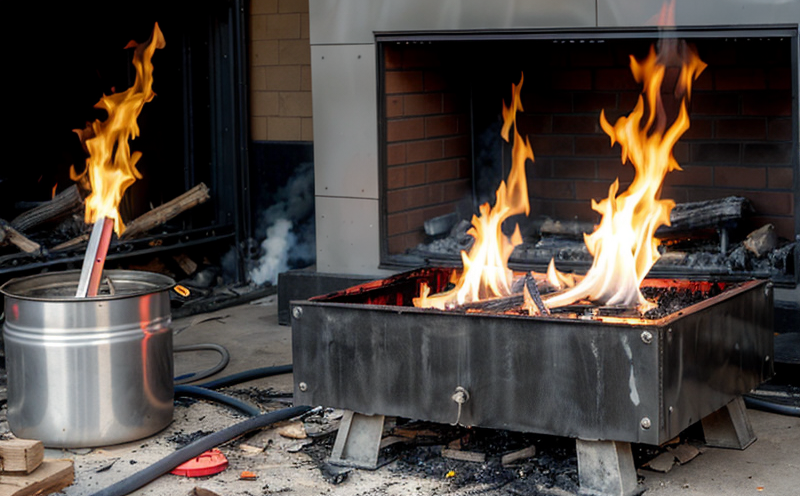NFPA 701 Flame Propagation Testing of Textiles
The National Fire Protection Association (NFPA) Standard 701 is a widely recognized and utilized standard for evaluating the flame resistance properties of textiles. This service involves testing how textiles behave under conditions that simulate real-world fire scenarios, providing critical data to ensure safety standards are met.
Fire & flammability tests are crucial in industries dealing with products that could potentially come into contact with open flames or high heat sources, such as furniture upholstery, drapery fabrics, and industrial textiles. The results of NFPA 701 testing can significantly impact a company's reputation, compliance with regulatory requirements, and consumer trust.
The test aims to determine the flame propagation characteristics of textile materials through measuring how fast or slow they ignite, burn, and extinguish when exposed to an open flame. This information is essential for manufacturers to ensure their products are safe from ignition risks while also meeting local and international fire safety codes.
Compliance with NFPA 701 standards not only helps protect consumers but also ensures that businesses adhere to strict industry regulations, thereby reducing the risk of product recalls and legal issues. This service is particularly important for companies operating in sectors like retail, hospitality, and manufacturing where textiles are central components.
The testing process involves carefully selecting samples from each batch or lot of fabric to be tested. These samples undergo rigorous examination using standardized test methods designed by NFPA 701. The results provide critical insights into the flame resistance properties of these materials, allowing manufacturers to make informed decisions about material selection and design.
Understanding the nuances of this testing process is vital for those involved in quality management, compliance officers, R&D engineers, and procurement teams within various industries. By ensuring that textiles meet strict fire safety standards, we contribute to a safer environment for all users.
Scope and Methodology
| Test Parameters | Conditions | Measurement |
|---|---|---|
| Flame Impingement Time | 5 seconds | Time taken for the flame to travel along the sample surface. |
| After Flame Time | 30 seconds | Duration during which the sample continues to burn after the flame source is removed. |
| Char Length | Measured from the point where char formation starts until it ends. | Total length of charring on the test specimen. |
| Flame Spread Index (FSI) | Range: 0-100 | Indicates relative flame spread performance, with lower values being safer. |
The NFPA 701 test involves placing a sample of the textile material on a standard holder and exposing it to an open gas flame. The time taken for the flame to travel across the width of the sample is recorded as the Flame Impingement Time. After the flame source is removed, the duration during which the sample continues to burn (After Flame Time) is measured.
The Char Length is also determined by measuring the total length of charring on the test specimen after the testing procedure has concluded. Finally, the Flame Spread Index (FSI), which ranges from 0-100, provides an overall assessment of how quickly and extensively the flame spreads across the material surface.
The results are then compared against established criteria to determine whether the sample meets NFPA 701 specifications. Compliance with these standards ensures that textile products have adequate fire resistance properties, protecting both users and property from potential hazards associated with flammable materials.
Customer Impact and Satisfaction
- Enhanced Product Safety: Meeting NFPA 701 requirements assures customers that their products are safe to use, reducing the risk of accidents or injuries due to fire hazards.
- Better Reputation: Compliance with this standard enhances a company's reputation by demonstrating commitment to quality and safety standards.
- Regulatory Compliance: Ensuring adherence to local and international regulations helps businesses avoid costly fines and penalties.
- Increased Consumer Trust: Providing safer products builds trust among consumers, leading to higher satisfaction levels and repeat business opportunities.
- Improved Quality Assurance: Regular testing helps identify potential issues early on in the production process, allowing for necessary adjustments before large-scale recalls are required.
In summary, NFPA 701 flame propagation testing of textiles offers numerous benefits to customers. It not only ensures product safety but also enhances brand reputation and regulatory compliance while fostering greater consumer trust and improved quality assurance practices within manufacturing processes.
Environmental and Sustainability Contributions
The NFPA 701 flame propagation testing of textiles plays a significant role in promoting environmental sustainability by encouraging the use of fire-resistant materials that can prevent fires from spreading. By reducing the likelihood of fires occurring, these sustainable practices help protect natural resources, reduce emissions associated with firefighting efforts, and minimize waste generated during fire incidents.
Manufacturers who invest in flame retardant technologies as part of their sustainability strategies contribute positively to global environmental goals. This approach supports efforts towards cleaner air quality, reduced carbon footprints, and overall better management of solid waste disposal practices.
Additionally, adhering to stringent fire safety standards like NFPA 701 helps promote responsible resource use throughout the product lifecycle—from raw material extraction through manufacturing processes all the way to end-of-life recycling or disposal. Such initiatives foster a circular economy model where resources are reused rather than discarded, promoting long-term environmental benefits.
By focusing on fire resistance properties during development stages, companies can create safer products that meet both current and future demands for enhanced safety measures without compromising on aesthetic appeal or functionality. This proactive approach towards sustainability contributes significantly to the overall well-being of society at large.





